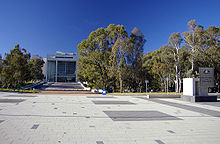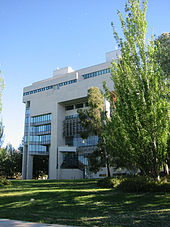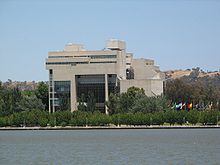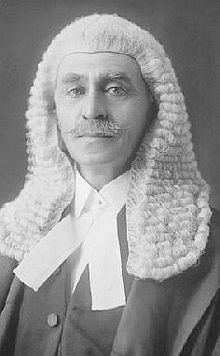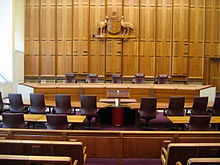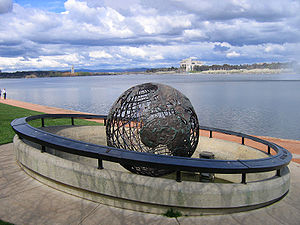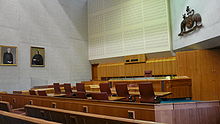- High Court of Australia
-
High Court of Australia 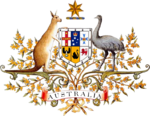
Established 1903 Jurisdiction Australia Location Canberra Composition method Vice-regal appointment upon Prime Ministerial nomination, following advice of Attorney-General and Cabinet Authorized by Constitution of Australia Judge term length Until age of 70 years (Constitution of Australia, s 72 following 1977 referendum) Number of positions 7, by statute Website www.hcourt.gov.au Chief Justice of Australia Currently Robert French Since 1 September 2008 The High Court of Australia is the supreme court in the Australian court hierarchy and the final court of appeal in Australia. It has both original and appellate jurisdiction, has the power of judicial review over laws passed by the Parliament of Australia and the parliaments of the States, and interprets the Constitution of Australia. The High Court is mandated by section 71 of the Constitution, which vests in it the judicial power of the Commonwealth of Australia. The High Court was constituted by the Judiciary Act 1903. The High Court of Australia is located in Canberra, Australian Capital Territory.
Contents
Role of the court
The High Court exercises both original jurisdiction (cases which originate in the High Court) and appellate jurisdiction (appeals made to the High Court from other courts). The High Court is the court of final appeal for the whole of Australia with the ability to interpret the common law for the whole of Australia, not just the state or territory in which the matter arose. This is unlike other high courts, such as the Supreme Court of the United States (though US federal courts do have the ability to shape US federal common law). As such, the court is able to develop the common law consistently across all of the states and territories. This role, alongside its role in constitutional interpretation, is one of the court's most significant. As Sir Owen Dixon said on his swearing in as Chief Justice of Australia:
"The High Court's jurisdiction is divided in its exercise between constitutional and federal cases which loom so largely in the public eye, and the great body of litigation between man and man, or even man and government, which has nothing to do with the Constitution, and which is the principal preoccupation of the court."[1]
This broad array of jurisdiction has enabled the High Court to take a leading role in Australian law, and has contributed to a consistency and uniformity among the laws of the different states.[2]
Original jurisdiction
The original jurisdiction of the High Court refers to matters which are originally heard in the High Court. The Constitution confers actual (section 75) and potential (section 76) original jurisdiction.
Section 75 of the Constitution confers original jurisdiction in regard to "all matters":
- (i) arising under any treaty
- (ii) affecting consuls or other representatives of other countries
- (iii) in which the Commonwealth, or a person suing or being sued on behalf of the Commonwealth, is a party
- (iv) between States, or between residents of different States, or between a State and a resident of another State
- (v) in which a writ of mandamus or prohibition or an injunction is sought against an officer of the Commonwealth.
The conferral of original jurisdiction creates some problems for the High Court. For example, challenges against immigration-related decisions are often brought against an officer of the Commonwealth within the original jurisdiction of the High Court.
Section 76 provides that Parliament may confer original jurisdiction in relation to matters:
- (i) arising under the constitution or involving its interpretation
- (ii) arising under any laws made by the Parliament
- (iii) of admiralty and maritime jurisdiction
- (iv) relating to the same subject-matter claimed under the laws of different states.
Constitutional matters, referred to in section 76(i), have been conferred to the High Court by section 30 of the Judiciary Act 1903. However, the inclusion of constitutional matters in section 76, rather than section 75, means that the High Court’s original jurisdiction regarding constitutional matters could be removed. In practice, section 75(iii) (suing the Commonwealth) and section 75(iv) (conflicts between states) are broad enough that many constitutional matters would still be within jurisdiction. The original constitutional jurisdiction of the High Court is now well established: the Australian Law Reform Commission has described the inclusion of constitutional matters in section 76 rather than section 75 as "an odd fact of history."[3] The 1998 constitutional convention recommended an amendment to the constitution to prevent the possibility of the jurisdiction being removed by Parliament. Failure to proceed on this issue suggests that it was considered highly unlikely that Parliament would ever take this step.
The requirement of "a matter" in section 75 and section 76 of the constitution means that a concrete issue must need to be resolved, and the High Court cannot give an advisory opinion.
Appellate jurisdiction
The High Court's appellate jurisdiction is defined under Section 73 of the Constitution. The High Court can hear appeals from the Supreme Courts of the States, from any federal court or court exercising federal jurisdiction (such as the Federal Court of Australia), and from decisions made by one or more Justices exercising the original jurisdiction of the court.
However, section 73 allows the appellate jurisdiction to be limited "with such exceptions and subject to such regulations as the Parliament prescribes". Parliament has prescribed a large limitation in section 35A of the Judiciary Act 1903. This requires "special leave" to appeal. Special leave is granted only where a question of law is raised which is of public importance; or involves a conflict between courts; or "is in the interests of the administration of justice". Therefore, while the High Court is the final court of appeal it cannot be considered to be a general court of appeal. The decision as to whether to grant special leave to appeal is determined by one or more Justices of the High Court (in practice, a panel of 2 or 3 judges). That is, Court exercises the power to decide which appeal cases it will consider.
The High Court and the Privy Council
The issue of appeals from the High Court to the United Kingdom's Judicial Committee of the Privy Council was a significant one during the drafting of the Constitution, and it continued to be significant in the years after the court's creation. The final wording of section 74 prohibited appeals on constitutional matters involving disputes about the limits inter se of Commonwealth or state powers, except where the High Court certified the appeal. It did so only once: in the case of Colonial Sugar Refining Co v Attorney-General (Commonwealth)[4] (1912). After that case, in which the Privy Council refused to answer the constitutional questions put to it, the High Court never certified another inter se appeal.[5] Indeed, in the case of Kirmani v Captain Cook Cruises Pty Ltd (No 2)[6] (1985), the court said that it would never again grant a certificate of appeal.
In general matters however, section 74 did not prevent the Privy Council from granting leave to appeal against the High Court's wishes, and the council did so often. In some cases, the council acknowledged that the Australian common law had developed differently from English law, and thus did not apply its own principles (for example, in Australian Consolidated Press Ltd v Uren[7] (1967), or in Viro v The Queen[8] (1978)), by using a legal fiction which stated that different common law can apply to different circumstances.[9] However, in other cases, the Privy Council enforced English decisions, overruling decisions by the High Court. In Parker v The Queen[10] (1963), Chief Justice Sir Owen Dixon led a unanimous judgment which rejected a precedent of the House of Lords in DPP v Smith, saying that "I shall not depart from the law on this matter as we have long since laid it down in this Court and I think that Smith's case should not be used in Australia as authority at all";[10] the following year the Privy Council upheld an appeal, applying the House of Lords precedent.[11]
Section 74 did provide that the parliament could make laws to prevent appeals to the council, and it did so, beginning in 1968, with the Privy Council (Limitation of Appeals) Act 1968, which closed off all appeals to the Privy Council in matters involving federal legislation. In 1975, the Privy Council (Appeals from the High Court) Act 1975 was passed, which had the effect of closing all routes of appeal from the High Court. Appeals from the High Court to the Privy Council are now only theoretically possible in inter se matters if the High Court grants a certificate of appeal under section 74 of the Constitution. As noted above, the High Court indicated in 1985 it would not grant such a certificate in the future, and it is practically certain that all future High Courts will maintain this policy. In 1986, with the passing of the Australia Acts by both the UK Parliament and the Parliament of Australia (with the ratification of the States), appeals to the Privy Council from state Supreme Courts were closed off, leaving the High Court as the only avenue of appeal.
Appellate jurisdiction for Nauru
As per an agreement between Nauru and Australia in 1976, in application of article 57 of the Constitution of Nauru, the High Court of Australia is the ultimate court of appeal for the sovereign Republic of Nauru, formerly an Australian colony. Thus the High Court may hear appeals from the Supreme Court of Nauru in both criminal and civil cases, with certain exceptions; in particular, no case pertaining to the Constitution of Nauru may be decided by the Australian court.[12]
History
The genesis of the court can be traced back to the mid 19th century. Before the establishment of the High Court, appeals from the state Supreme Courts could be made only to the Judicial Committee of the Privy Council, which involved the great expense of physically travelling to London. As such, some politicians in the colonies wanted to have a new court which could travel between the colonies hearing appeals.
Following Earl Grey's 1846 proposal for federation of the Australian colonies, an 1849 report from the Privy Council of the United Kingdom suggested that a national court be created.[13] In 1856, the then Governor of South Australia, Richard Graves MacDonnell, suggested to the Government of South Australia that they and the other colonies should consider establishing a court of appeal which would hear appeals from the Supreme Courts in each colony, and in 1860 the Parliament of South Australia passed legislation encouraging MacDonnell to put forward the idea to his colleagues in the other colonies. However, only the Government of Victoria seriously considered this proposal.[14]
At an inter-colonial conference in 1870 in Melbourne, Victoria, the idea of an inter-colonial court was again raised, and subsequently a Royal Commission was established in Victoria, to investigate options not only for establishing a court of appeal, but for unifying extradition laws between the colonies and other similar matters. A draft bill establishing a court was put forward by the Commission, but it completely excluded appeals to the Privy Council, which reacted critically and prevented any serious attempts to implement the bill in London (before federation, any laws affecting all the colonies would have to be passed by the British Imperial Parliament in London).[14]
In 1880, another inter-colonial conference was convened, which proposed the establishment of an Australasian Court of Appeal. This conference was more firmly focused on having an Australian court. Another draft bill was produced, providing that judges from the colonial Supreme Courts would serve one-year terms on the new court, with one judge from each colony at a given time. New Zealand, which was at the time also considering joining the Australian colonies in federation, was also to be a participant in the new court.[14] However, the proposal retained appeals from colonial Supreme Courts to the Privy Council, which some of the colonies disputed, and the bill was eventually abandoned.
Constitutional conventions
The Constitutional Conventions of the 1890s, which met to draft an Australian Constitution, also raised the idea of a federal Supreme Court. Initial proposals at a conference in Melbourne in February 1890 led to a convention in Sydney in March and April 1891, which produced a draft constitution. The draft included the creation of a Supreme Court of Australia, which would not only interpret the Constitution, like the United States Supreme Court, but also would be a court of appeal from the state Supreme Courts. The draft effectively removed appeals to the Privy Council, allowing them only if the British monarch gave leave to appeal and not allowing appeals at all in constitutional matters.
This draft was largely the work of Sir Samuel Griffith,[5] then the Premier of Queensland, later Chief Justice of Queensland and the first Chief Justice of Australia. Other significant contributors to the judicial clauses in the draft included Attorney-General of Tasmania Andrew Inglis Clark, who had prepared his own constitution prior to the convention. Inglis Clark's most significant contribution was to give the court its own constitutional authority, ensuring the separation of powers; the original formulation from Griffith, Edmund Barton and Charles Kingston provided only that the parliament could establish a court.[13]
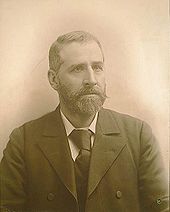 Andrew Inglis Clark, prominent contributor to the clauses about the High Court in the Constitution of Australia.
Andrew Inglis Clark, prominent contributor to the clauses about the High Court in the Constitution of Australia.
At the later conventions, in Adelaide in 1897, in Sydney later the same year and in Melbourne in early 1898, there were changes to the earlier draft. In Adelaide, the name of the court was changed from Supreme Court of Australia to High Court of Australia. Many people also opposed the new court completely replacing the Privy Council: many large businesses, particularly those which were subsidiaries of British companies or regularly traded with the United Kingdom, preferred for business reasons to keep the colonies under the unified jurisdiction of the British courts, and petitioned the conventions to that effect.[5] Other arguments posited against removing Privy Council appeals were that Australian judges were of a poorer quality than English ones, and that without the Council's oversight, the law in the colonies risked becoming different from English law.[13] Some politicians, such as Sir George Dibbs, supported the petitioners, but others, including Alfred Deakin, supported the design of the court as it was.[5] Inglis Clark took the view that the possibility of divergence was a good thing, for the law could adapt appropriately to Australian circumstances.[13] Despite the debate, the portions of the draft dealing with the court remained largely unchanged, as the delegates focused on different matters.
After the draft had been approved by the electors of the colonies, it was taken to London in 1899, for the assent of the British Imperial Parliament. However the issue of Privy Council appeals remained a sticking point with a number of Australian and British politicians, including the Secretary of State for the Colonies, Joseph Chamberlain, the Chief Justice of South Australia, Sir Samuel Way, and the Chief Justice of Queensland, Sir Samuel Griffith.[9] Indeed, in October 1899, Griffith made representations to Chamberlain soliciting suggestions from British ministers for alterations to the draft, and offering some alterations of his own.[9] Indeed, such was the effect of these and other representations that Chamberlain called for delegates from the colonies to come to London to assist with the approval process, with a view to their approving any alterations that the British government might see fit to make; delegates were sent, including Deakin, Barton and Charles Kingston, although they were under instructions that they would never agree to changes.[9]
After intense lobbying both in Australia and in the United Kingdom, the Imperial Parliament finally approved the draft constitution, albeit with an altered section 74, which represented a compromise between the two sides: there would be a general right of appeal from the High Court to the Privy Council, except that the Parliament of Australia would be able to make laws restricting this avenue, and also that appeals in inter se matters (matters concerning the boundary between and limits of the powers of the Commonwealth and the powers of the states) were not as of right, but had to be certified by the High Court.[9]
Formation of the court
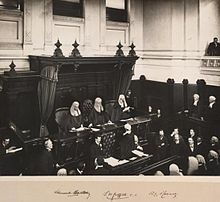 The first Chief Justice of Australia, Sir Samuel Griffith, is administered the judicial oath at the first sitting of the High Court, in the Banco Court of the Supreme Court of Victoria, 6 October 1903.
The first Chief Justice of Australia, Sir Samuel Griffith, is administered the judicial oath at the first sitting of the High Court, in the Banco Court of the Supreme Court of Victoria, 6 October 1903.
The Constitution was passed by the Imperial Parliament, and came into effect on 1 January 1901. However, the High Court was not established straightaway; it was necessary for the new Parliament to make laws about the structure and procedure of the court. Some of the members of the First Parliament, including Sir John Quick, then one of the leading legal experts in Australia, opposed legislation to set up the court. Even H. B. Higgins, who was himself later appointed to the court, objected to setting it up, on the grounds that it would be impotent while Privy Council appeals remained, and that in any event there was not enough work for a federal court to make it viable.[5]
In 1902, the then Attorney-General Alfred Deakin introduced the Judiciary Bill 1902 into the parliament. Although Deakin and Griffith had produced a draft bill as early as February 1901, it was continually delayed by opponents in the parliament, and the success of the bill is generally attributed to Deakin's passion and effort in pushing the bill through the parliament despite this opposition.[13] Deakin had proposed that the court be composed of five judges, specially selected to the court; opponents instead proposed that the court should be made up of state Supreme Court justices, taking turns to sit on the High Court on a rotation basis, as had been mooted at the Constitutional Conventions a decade before.[15] Deakin eventually negotiated amendments with the opposition, reducing the number of judges from five to three, and eliminating financial benefits such as pensions.
At one point, Deakin even threatened to resign as Attorney-General due to the difficulties he faced.[13] In what is now a famous speech, Deakin gave a second reading to the House of Representatives, lasting three and a half hours, in which he declared:
"The federation is constituted by distribution of powers, and it is this court which decides the orbit and boundary of every power... It is properly termed the keystone of the federal arch... The statute stands and will stand on the statute-book just as in the hour in which it was assented to. But the nation lives, grows and expands. Its circumstances change, its needs alter, and its problems present themselves with new faces. [The High Court] enables the Constitution to grow and be adapted to the changeful necessities and circumstances of generation after generation that the High Court operates."[16]
Deakin's friend, painter Tom Roberts, who viewed the speech from the public gallery, declared it Deakin's "magnum opus".[13] The Judiciary Act 1903 was finally passed on 25 August 1903, and the first three justices, Chief Justice Sir Samuel Griffith and Justices Sir Edmund Barton and Richard O'Connor were appointed on 5 October of that year. On 6 October, the court held its first sitting in the Banco Court in the Supreme Court of Victoria.
First years of the court
 The court's home between 1928 and 1980, the purpose-built courtroom in Little Bourke Street, Melbourne.
The court's home between 1928 and 1980, the purpose-built courtroom in Little Bourke Street, Melbourne.
After the court's first sitting in the Banco Court in Melbourne, the court continued to use that court until 1928, when a dedicated courtroom was built in Little Bourke Street, next to the Supreme Court of Victoria, which provided the court's Melbourne sitting place and housed the court's principal registry until 1980.[17] The court also sat regularly in Sydney, where it originally shared space in the Criminal Courts in the suburb of Darlinghurst, before a dedicated courtroom was constructed next door in 1923.[18]
The court travelled to other cities across the country, where it did not have any facilities of its own, but used facilities of the Supreme Court in each city. Alfred Deakin had envisaged that the court would sit in many different locations, so as to truly be a federal court. Shortly after the court's creation, Chief Justice Griffith established a schedule for sittings in state capitals: Hobart, Tasmania in February, Brisbane, Queensland in June, Perth, Western Australia in September and Adelaide, South Australia in October; it is said that Griffith established this schedule because those were the times of year he found the weather most pleasant in each city. The tradition remains to this day, although most of the court's sittings are now conducted in Canberra.
Sittings were dependent on the caseload, and to this day sittings in Hobart occur only once every few years. There are annual sittings in Perth, Adelaide and Brisbane for up to a week each. During the Great Depression, sittings outside of Melbourne and Sydney were suspended in order to reduce costs.
During World War II, the court faced a period of change. The Chief Justice, Sir John Latham, served from 1940 to 1941 as Australia's first ambassador to Japan, although his activities in this role were limited by the mutual assistance pact that Japan had entered into with the Axis powers before he could arrive in Tokyo, and were curtailed by the commencement of the Pacific War.[19] Justice Sir Owen Dixon was also absent for several years, while he served as Australia's minister to the United States in Washington.[20] Sir George Rich was Acting Chief Justice in Latham's absence. There were many difficult cases concerning the federal government's use of the defence power during the war.
Post-war period
From 1952, with the appointment of Sir Owen Dixon as Chief Justice, the court entered a period of stability. After World War II, the court's workload continued to grow, particularly from the 1960s onwards, putting pressures on the court.[21] Sir Garfield Barwick, who was Attorney-General from 1958 to 1964, and from then till 1981 Chief Justice, proposed that more federal courts be established, as permitted under the Constitution. In 1976 the Federal Court of Australia was established, with a general federal jurisdiction, and in more recent years the Family Court and Federal Magistrates Court have been set up to reduce the court's workload in specific areas.
Recent history
Building
In the 1950s the then Prime Minister Robert Menzies had established a plan to develop Canberra, and construct other important national buildings. In 1959, a plan featured a new building for the High Court on the shores of Lake Burley Griffin, next to the location for the new Parliament House, and the National Library of Australia.[citation needed] This plan was abandoned in 1968, and the location of the Parliament was moved, later settling on the present site on Capital Hill.[citation needed]
In March 1968, the government announced that the court would move to Canberra.[citation needed] In 1972 an international competition was held attracting 158 entries. In 1973 the firm of Edwards Madigan Torzillo Briggs was declared the winner of the two-stage competition. Architect Chris Kringas was the Principal Designer and Director in charge of the design team that included Feiko Bouman and Rod Lawrence. In 1975, only one month before construction began, Kringas died aged 38. Following his death, Architect Hans Marelli and Colin Madigan supervised the construction of the design.[22]
Construction began in April 1975 on the shore of Lake Burley Griffin, in the Parliamentary Triangle. The site is just to the east of the axis running between Capital Hill and the Australian War Memorial. The High Court building houses three courtrooms, Justices' chambers, and the Court's main registry, library, and corporate services facilities. It is an unusual and distinctive structure, built in the brutalist style, and features an immense public atrium with a 24 metre high roof. The neighbouring National Gallery was also designed by the firm of Edwards Madigan Torzillo and Briggs. There are similarities between the two buildings in material and style but significant differences in architectural form and spatial concept. The building was completed in 1980, and the majority of the court's sittings have been held in Canberra since then.
The High Court and National Gallery Precinct were added to the Australian National Heritage List in November 2007.[23]
Jurisprudence
The legal history of the court is commonly summarised by reference to the Chief Justice of the time.
Griffith court
As the first High Court, the court under Chief Justice Sir Samuel Griffith had to establish its position as a new court of appeal for the whole of Australia, and had to develop a new body of principle for interpreting the Constitution of Australia and federal legislation. Griffith himself was very much the dominant influence on the court in its early years, but after the appointment of Sir Isaac Isaacs and H. B. Higgins in 1906, and the death of foundation Justice Richard O'Connor, Griffith's influence began to decline.[24]
The court was keen to establish its position at the top of the Australian court hierarchy. In Deakin v Webb[25] (1904) Griffith criticised the Supreme Court of Victoria for following a Privy Council decision about the Constitution of Canada, rather than following the High Court's own decision on the Australian Constitution.[14]
In Australian constitutional law, the early decisions of the court were influenced by United States constitutional law. In the case of D'Emden v Pedder[26] (1904), which involved the application of Tasmanian stamp duty to a federal official's salary, the court adopted the doctrine of implied immunity of instrumentalities which had been established in the United States Supreme Court case of McCulloch v. Maryland[27] (1803). That doctrine established that any attempt by the federal government to interfere with the legislative or executive power of the states was invalid, and vice versa. Accompanying that doctrine was the doctrine of reserved State powers, which was based on the principle that the powers of the federal parliament should be interpreted narrowly, to avoid intruding on areas of power traditionally exercise by the state parliaments. The concept was developed in such cases as Peterswald v Bartley[28] (1904), R v Barger[29] (1908) and the Union Label case[30] (1908).
Together the two doctrines helped smooth the transition to a federal system of government, and "by preserving a balance between the constituent elements of the Australian federation, probably conformed to community sentiment, which at that stage was by no means adjusted to the exercise of central power."[24] The court had a generally conservative view of the Constitution, taking narrow interpretations of section 116 (which guarantees religious freedom) and section 117 (which prevents discrimination on the basis of someone's state of origin), interpretations that were to last well into the 1980s.[24]
Two of the original judges of the Court, Griffith and Sir Edmund Barton, were frequently consulted by governors-general, including on the exercise of the reserve powers.[31] This practice of consultation has continued from time to time since.
Knox, Isaacs and Gavan Duffy courts
Adrian Knox (later Sir Adrian) became Chief Justice on 18 October 1919, and less than three months later, foundation Justice Sir Edmund Barton died, leaving no original members. The most significant case of the era was the Engineers case[32] (1920), decided at the beginning of Knox's term. In that case, the doctrines of reserved State powers and implied immunity of instrumentalities were both overturned, and the court entered a new era of constitutional interpretation in which the focus would fall almost exclusively on the text of the Constitution, and in which the powers of the federal parliament would gain increasing importance.
Knox was knighted in 1921, the only Chief Justice to be first knighted during his term. Some of the Knox court's early work related to the aftermath of World War I. In Roche v Kronheimer[33] (1921), the court upheld federal legislation which allowed for the making of regulations to implement Australia's obligations under the Treaty of Versailles. The majority decided the case on the defence power, but Higgins decided it on the external affairs power, the first case to decide that the external affairs power could be used to implement an international treaty in Australia.
Sir Isaac Isaacs was Chief Justice for only forty-two weeks, before leaving the court to be appointed Governor-General of Australia. Isaacs was ill for much of his term as Chief Justice, and few significant cases were decided under his formal leadership; rather, his best years were under Knox, where he was the most senior puisne Justice and led the court in many decisions.[34]
Sir Frank Gavan Duffy was Chief Justice for four years beginning in 1931, although he was already 78 when appointed to the position and did not exert much influence, given that (excluding single-Justice cases) he participated in only 40 per cent of cases in that time, and regularly gave short judgments or joint judgments with other Justices.[35] In the context of the Great Depression, the court was reduced to six Justices, resulting in many tied decisions which have no lasting value as precedent.
During this time, the court did decide several important cases, including Attorney-General (New South Wales) v Trethowan[36] (1931), which considered Premier of New South Wales Jack Lang's attempt to abolish the New South Wales Legislative Council, and the First State Garnishee case[37] (1932), which upheld federal legislation compelling the Lang government to repay its loans. Much of the court's other work related to legislation passed in response to the Depression.
Latham court
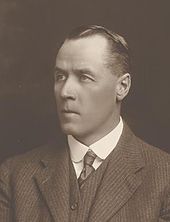 John Latham, before his appointment to the court, as Deputy Prime Minister and Minister for External Affairs in the Lyons government.
John Latham, before his appointment to the court, as Deputy Prime Minister and Minister for External Affairs in the Lyons government.
The court under Chief Justice Sir John Latham, who came to the office in 1935, was punctuated by World War II. Although it dealt with cases in other areas, its most important and lasting work related to wartime legislation, and the transition back to peace following the war.[38] The court upheld much legislation under the defence power, interpreting it broadly wherever there was a connection to defence purposes, in cases such as Andrews v Howell[39] (1941) and de Mestre v Chisholm[40] (1944). In general, the Curtin Labor government was rarely successfully challenged, the court recognising the necessity that the defence power permit the federal government to govern strongly. The court also allowed the federal government to institute a national income tax scheme in the First Uniform Tax case[41] (1942), and upheld legislation allowing the proclamation of the pacifist Jehovah's Witnesses religion as a subversive organisation, in the Jehovah's Witnesses case[42] (1943).
The court reined in the wide scope of the defence power after the war, allowing for a transitional period. It struck down several key planks of the Chifley Labor government's reconstruction program, notably an attempt to nationalise the banks in the Bank Nationalisation case[43] (1948), and an attempt to establish a comprehensive medical benefits scheme in the First Pharmaceutical Benefits case[44] (1945). However the court also famously struck down Menzies Liberal government legislation banning the Communist Party of Australia in the Communist Party case[45] (1951), Latham's last major case.
Apart from the wartime cases, the Latham court also developed the criminal defence of honest and reasonable mistake of fact, for example in Proudman v Dayman[46] (1941). It also paved the way for the development of the external affairs power by upholding the implementation of an air navigation treaty in R v Burgess; Ex parte Henry[47] (1936).
Dixon court
Under Chief Justice Sir Owen Dixon, who was elevated to that role in 1952 after 23 years as a puisne Justice, the court enjoyed its most successful period, with British judge, Master of the Rolls Lord Denning, describing the time as the court's "Golden Age".[48] Dixon, widely regarded as Australia's greatest judge, had a commanding personal and legal influence over the court in this time, measurable in the rise in joint judgments (many of which were led by Dixon) and good relations between the Justices.[48]
While there were fewer cases which tested the limits of federal power, which was probably due to the Menzies government which was firmly entrenched in its conservative phase throughout Dixon's tenure, the court did decide several important constitutional cases. Dixon led the court in firmly establishing the separation of powers for the judiciary in the Boilermakers' case[49] (1956), and the court also upheld the continuing existence of the federal government's income tax scheme in the Second Uniform Tax case[50] (1957).
During Dixon's time as Chief Justice, the court came to adopt several of the views that Dixon had advanced in minority opinions in years prior. In several cases, the court upheld Dixon's interpretation of section 92 of the Australian Constitution (one of the most troublesome sections of the Constitution), which he regarded as guaranteeing a constitutional right to engage in interstate trade, subject to reasonable regulation. It also followed Dixon's interpretation of section 90 (which prohibits the states from exacting duties of excise), although both these interpretations were ultimately abandoned many years later.[48]
Barwick court
Sir Garfield Barwick came to the court as Chief Justice in 1964. A significant decision of the Barwick court marked the beginning of the modern interpretation of the corporations power, which had been interpreted narrowly since 1909. The Concrete Pipes case[51] (1971) established that the federal parliament could exercise the power to regulate at least the trading activities of corporations, whereas earlier interpretations had allowed only the regulation of conduct or transactions with the public.
The court decided many other significant constitutional cases, including the Seas and Submerged Lands case[52] (1975), upholding legislation asserting sovereignty over the territorial sea; the First[53] (1975) and Second[54] (1977) Territory Senators cases, which concerned whether legislation allowing for the mainland territories to be represented in the Parliament of Australia was valid; and Russell v Russell[55] (1976), which concerned the validity of the Family Law Act 1975. The court also decided several cases relating to the historic 1974 joint sitting of the Parliament of Australia, including Cormack v Cope[56] (1974) and the Petroleum and Minerals Authority case[57] (1975).
The Barwick court decided several infamous cases on tax avoidance and tax evasion, almost always deciding against the taxation office. Led by Barwick himself in most judgments, the court distinguished between avoidance (legitimately minimising one's tax obligations) and evasion (illegally evading obligations). The decisions effectively nullified the anti-avoidance legislation, and led to the proliferation of avoidance schemes in the 1970s, a result which drew much criticism upon the court.[58]
Gibbs court
Sir Harry Gibbs was appointed as Chief Justice in 1981. Under his leadership, the court moved away from the legalism and conservative traditions which had characterised the Dixon and Barwick courts.[59]
The Gibbs court made several important decisions in Australian constitutional law. It allowed the Federal Parliament to make very wide use of the external affairs power, by holding that this power could be used to implement treaties into domestic law with very few justiciable limits. In Koowarta v Bjelke-Petersen[60] (1982) four judges to three upheld the validity of the Racial Discrimination Act 1975, although no single view had majority support. However, in the Tasmanian Dams case[61] (1983), a majority of the court upheld federal environmental legislation under the power.
The court also adopted a more expansive interpretation of the corporations power. In the Actors Equity case[62] (1982), the court upheld regulations which, although they did not directly regulate corporations, indirectly protected corporations. In the Tasmanian Dams case, the court indicated that it would interpret the power to uphold legislation regulating the non-trading activities of corporations, although it did not decide the case on that basis. The external affairs power and the corporations power have both been increasingly relied on by the federal government to extend its authority in recent years.[59]
In administrative law, the court expanded on the doctrines of natural justice and procedural fairness in Kioa v West[63] (1985). Although Gibbs himself dissented on those points, he did decide that executive decision makers were obliged to take humanitarian principles into consideration. Outside of specific areas of law, the court was also involved in several cases of public significance, including the Chamberlain case[64] (1984), concerning Lindy Chamberlain, and A v Hayden[65] (1984), concerning the botched ASIS exercise at the Sheraton Hotel in Melbourne.
Mason court
Sir Anthony Mason became Chief Justice in 1987. The Mason court was very stable with only one change in the bench in its eight years, the appointment of Michael McHugh after Sir Ronald Wilson's retirement. The court under Mason was widely regarded as the most liberal bench in the court's history.
The Mason court made many important decisions in all areas of Australian law. One of its first major cases was Cole v Whitfield[66] (1988), concerning the troublesome section 92 of the Australian Constitution, which had been interpreted inconsistently and confusingly since the beginning of the court. For the first time, the court referred to historical materials such as the debates of the Constitutional Conventions in order to ascertain the purpose of the section, and the unanimous decision indicated "a willingness to overturn established doctrines and precedents perceived to be no longer working", a trend which typified the Mason court.[67]
The most popularly significant case decided by the Mason court was the Mabo case[68] (1992), in which the court found that the common law was capable of recognising native title. The decision was one of the High Court's most controversial of all time, and represented the tendency of the Mason court to receive "high praise and stringent criticism in equal measure."[67] Other controversial cases included the War Crimes Act case[69] (1991), regarding the validity of the War Crimes Act 1945; Dietrich v The Queen[70] (1992), in which the court found that a lack of legal representation in a serious criminal case can result in an unfair trial; Sykes v Cleary[71] (1992), regarding the disputed election of Phil Cleary; and Teoh's case[72] (1995), in which the court held that ratification of a treaty by the executive could create a legitimate expectation that members of the executive would act in accordance with that treaty.
The court developed the concept of implied human rights in the Constitution, in cases such as Australian Capital Television Pty Ltd v Commonwealth[73] (1992), Nationwide News v Wills[74] (1992) and Theophanous v Herald and Weekly Times[75] (1994), in which the court recognised an implied freedom of political communication arising from the nature of the Constitution in laying out a system of representative government.
In other areas of law, the court developed doctrines of equity in relation to commercial law and contract law, in cases such as Waltons Stores v Maher (1988)[76] and Trident General Insurance v McNiece[77] (1988), and made significant developments in tort law, in cases such as Rogers v Whitaker[78] (1992) and Burnie Port Authority v General Jones[79] (1994).
Brennan court
Sir Gerald Brennan succeeded Mason in 1995. In contrast to the previous court, the Brennan court had many changes in its membership despite being only three years long. The court decided many significant cases.[80]
In Ha v New South Wales[81] (1997) the court invalidated a New South Wales tobacco licensing scheme, reining in the licensing scheme exception to the prohibition states levying excise duties, contained in section 90 of the Australian Constitution. While it did not overturn previous cases in which schemes had been upheld, it did emphasise that the states could not stray too far from the constitutional framework.
The Brennan court made a number of significant decisions in relation to the judiciary of Australia. In Grollo v Palmer[82] (1995) and Wilson v Minister for Aboriginal and Torres Strait Islander Affairs[83] (1998), the court developed the persona designata doctrine, and in Kable v DPP[84] (1997), the court rejected attempts by the Parliament of New South Wales to establish a system of preventative detention, and found that the states do not have unlimited ability to regulate their courts, given the place of the courts in the Australian court hierarchy.
The court decided several cases relating to the implied freedom of political communication developed by the Mason court, notably Lange v Australian Broadcasting Corporation[85] (1997) and Levy v Victoria[86] (1997). It also decided several native title cases, including the controversial Wik case[87] (1996).
Gleeson court
Murray Gleeson (the first Chief Justice not to be knighted) was appointed Chief Justice in 1998. The court under Gleeson's leadership was generally regarded as more conservative than under Mason or Brennan, favouring legalism in the tradition of the Dixon and Barwick courts. In many cases the Gleeson court focused heavily on the text itself when interpreting the Constitution or a particular statute. In the Cross-vesting case[88] (1999), the court struck down legislation vesting certain areas of federal jurisdiction in the Supreme Courts of the states. In Al-Kateb v Godwin[89] (2004) a majority of the court applied a narrow interpretation of the Migration Act 1958, finding that it permitted executively-imposed indefinite detention of stateless persons.
However, the court did not entirely shy away from principle and public policy in its decisions.[90] In Egan v Willis[91] (1998), the court supported the New South Wales Legislative Council's ability to suspend the Treasurer when he failed to produce documents before the Council, emphasising the purpose of the ability in facilitating responsible government. In Sue v Hill[92] (1999), the court recognised Australia's emergence as a sovereign independent nation, finding that the United Kingdom was a "foreign power".
The Gleeson court decided a number of important native title cases, including Yanner v Eaton[93] (1999), Western Australia v Ward[94] (2002) and the Yorta Yorta case[95] (2002). In tort law, the court's significant decisions include Perre v Apand Pty Ltd[96] (1999), concerning negligence actions where there is only pure economic loss as opposed to physical or mental injury, Dow Jones v Gutnick[97] (2002), regarding defamation on the Internet, and Cattanach v Melchior[98] (2003), a wrongful life case involving a healthy child. In criminal law, the court in R v Tang[99] (2008) upheld slavery convictions against the owner of a brothel who had held several women in debt bondage after they had been trafficked to Australia.
Perhaps the Gleeson court's most significant case was amongst its later ones. In the WorkChoices case[100] (2006), in which the court finally explicitly accepted a wide reading of the corporations power, after years of gradual expansion following the Concrete Pipes case[51] (1971).
French court
The present Chief Justice of Australia, Robert French, was appointed in September 2008. The first decision handed down by the French Court was Lujans v Yarrabee Coal Company Pty Ltd (2008),[101] a case dealing with a motor vehicle accident. One of the most notable judgments handed down by the French Court was Pape v Commissioner of Taxation[102] (2009), a Constitutional law case concerning the existence of the Commonwealth's so-called "appropriation power", and the scope of its executive and taxation powers.
Composition of the court
The High Court of Australia is composed of seven Justices: the Chief Justice of Australia and six other (puisne) Justices. The current Justices are:
The first three justices of the High Court were:
- Chief Justice, Sir Samuel Griffith
- Justice Sir Edmund Barton
- Justice Richard Edward O'Connor
There were a number of possible candidates for the first bench of the High Court. In addition to the eventual appointees, Griffith, Barton and O'Connor, names which had been mentioned in the press included two future Justices of the court, Henry Higgins and Isaac Isaacs, along with Andrew Inglis Clark, Sir John Downer, Sir Josiah Symon and George Wise. (Crucially, all of the above had previously served as politicians, with only Griffith and Inglis Clark possessing both political and judicial experience). Barton and O'Connor were both members of the federal parliament, and both from the government benches; indeed Barton was Prime Minister. Each of the eventual appointees had participated in the drafting of the Constitution, and had intimate knowledge of it. All three were described as conservative, and their jurisprudence was very much influenced by English law, and in relation to the Constitution, by United States law.
In 1906, at the request of the Justices, two more seats were added to the bench, with Isaacs and Higgins the appointees. After O'Connor's death in 1912, an amendment to the Judiciary Act 1903 expanded the bench to seven. For most of 1930 two seats were left vacant, due to monetary constraints placed on the court by the Depression. The economic downturn had also led to a reduction in litigation, and consequently less work for the court. After Sir Isaac Isaacs retired in 1931, his seat was left empty, and in 1933 an amendment to the Judiciary Act officially reduced the number of seats to six. However, this led to some decisions being split three-all. With the appointment of William Webb in 1946, the number of seats returned to seven, and since then the court has had a full complement of seven Justices. As of 2007[update] there have been 46 Justices, eleven of whom have been Chief Justice. Current Justices Susan Crennan and Susan Kiefel are the second and third women to sit on the bench, after Justice Mary Gaudron. With Virginia Bell having taken office in February 2009, there are three women sitting concurrently on the bench, alongside four men.
More than half of the Justices, twenty-four, have been residents of New South Wales (with twenty-three of these graduates of Sydney Law School). Thirteen were from Victoria, six from Queensland and three from Western Australia. No Justices have been residents of South Australia or Tasmania, or any of the territories. The majority of the justices have been from Protestant backgrounds, with a smaller number from Catholic backgrounds. Sir Isaac Isaacs was of Polish/Jewish background, the only representative of any other faith. He also remains the only High Court Justice from a non Anglo-Celtic background. Michael Kirby was the first openly gay justice in the history of the Court; his replacement Virginia Bell is the first lesbian,[103] who has been an active campaigner for gay and lesbian rights and was one of the participants in the first Sydney Gay and Lesbian Mardi Gras in 1978.[104]
Almost every single judge on the High Court has taken silk as a QC or KC before appointment. The exceptions are: Justice Sir Hayden Starke (although he refused to take silk), Justices Sir Edward McTiernan, Sir William Webb, Sir Cyril Walsh, Michael Kirby and now Chief Justice Robert French.
Since the retirement of Ian Callinan in 2007, every justice of the High Court, for the first time in its history, has had prior judicial experience (serving on state Supreme Courts or the Federal Court of Australia. Although 13 justices of the Court had previously served in state, colonial or federal Parliaments, no parliamentarian has been appointed to the Court since Lionel Murphy's appointment in 1975.
Appointment process
Appointments are officially made by the Governor-General in Council. In practice, appointees are nominated by the Prime Minister, on advice from the Cabinet, particularly from the Attorney-General of Australia. For example, four Justices were appointed while Andrew Fisher was Prime Minister, but it was largely on Attorney-General Billy Hughes' authority that the candidates were chosen.[citation needed] Since 1979, the Attorney-General has been required by section 6 of the High Court of Australia Act 1979 to consult with the Attorneys-General of the states and territories of Australia about appointments to the court. The process was first used in relation to the appointment of Justice Wilson, and has been generally successful, despite the occasional criticism that the states merely have a consultative, rather than a determinative, role in the selection process.[105]
There are no qualifications for Justices in the Constitution (other than that they must be under the retirement age of 70). The High Court of Australia Act requires that appointees have been a judge of a federal, state or territory court, or that they have been enrolled as a legal practitioner for at least five years, with either the High Court itself or with a state or territory Supreme Court. There are no other formal requirements.[106]
The appointment process stands in stark contrast with the highly public selection and confirmation process for justices of the Supreme Court of the United States. While there are people who are critical of the secrecy of the process, and who advocate a more public method for appointments, there are relatively few who dispute the quality of appointees.[citation needed] Although three of the Chief Justices (Sir Adrian Knox, Sir John Latham and Sir Garfield Barwick) were conservative politicians at the time of their appointment, and were appointed by conservative governments, their political views are not considered to have interfered with their performance on the court, and their talent is rarely questioned.[citation needed] However, there is frequent criticism of Barwick's intervention in the 1975 Australian constitutional crisis, when he gave advice to Governor-General Sir John Kerr.[citation needed] On the other side of politics, Labor politicians H. V. Evatt, Sir Edward McTiernan, and Lionel Murphy were also appointed to the High Court; Murphy's appointment was controversial at the time and his reputation was gravely damaged in 1985 by charges that he had attempted to pervert the course of justice, although he was eventually acquitted.[citation needed]
See also
- Australian court hierarchy
- Judiciary Act 1903
- Judiciary of Australia
- Law of Australia
- List of High Court of Australia cases
- List of Justices of the High Court of Australia
- List of Justices of the High Court of Australia by time in office
- List of Chief Justices of Australia by time in office
- Sir Samuel Griffith
- Sir Edmund Barton
- United States Supreme Court
References
- ^ Owen Dixon (1952). "Address on being sworn in as Chief Justice". Commonwealth Law Reports 85: XIII.
- ^ Bennett, J.M. (1980). "Foreword by Sir Garfield Barwick". Keystone of the Federal Arch. Canberra: Australian Government Publishing Service. ISBN 0-642-04866-5.
- ^ Australian Law Reform Commission. "The Judicial Power of the Commonwealth". Australian Legal Information Institute. http://www.austlii.edu.au/au/other/alrc/publications/reports/92/ch12.html#Heading7. Retrieved 2006-03-19.
- ^ (1912) 15 CLR 182
- ^ a b c d e Hull, Crispin (2003). The High Court of Australia: celebrating the centenary 1903-2003. Lawbook Co.. ISBN 0-455-21947-8.
- ^ [1985] HCA 27; (1985) 159 CLR 461
- ^ [1967] HCA 21; (1967) 117 CLR 221
- ^ [1978] HCA 9; (1978) 141 CLR 88
- ^ a b c d e "Murray Gleeson — The birth, life and death of Section 74". High Court of Australia. http://www.hcourt.gov.au/speeches/cj/cj_griffith2.htm. Retrieved 10 December 2005.
- ^ a b [1963] HCA 14; (1963) 111 CLR 610
- ^ Parker v The Queen [1964] AC 1369; (1964) 111 CLR 665
- ^ Agreement between the Government of Australia and the Government of the Republic of Nauru relating to Appeals to the High Court of Australia from the Supreme Court of Nauru, 1976
- ^ a b c d e f g Williams, John (2003). One hundred years of the High Court of Australia. King's College, London. ISBN 1-85507-124-X.
- ^ a b c d Bennett, J.M. (1980). Keystone of the Federal Arch. Canberra: Australian Government Publishing Service. ISBN 0-642-04866-5.
- ^ McHugh, Michael (15 February 2002). "The High Court and the Oxford Companion to the High Court". High Court of Australia. http://www.hcourt.gov.au/speeches/mchughj/mchughj_oxford.htm. Retrieved 2007-12-03.
- ^ Alfred Deakin (1902). "Judiciary Bill, second reading". Commonwealth Parliamentary Debates 8: 10967.
- ^ "High Court Building". Our Nation's First Capital. Public Records Office Victoria. http://www.prov.vic.gov.au/exhibs/ournation/f_hcb.htm. Retrieved 2007-12-04.
- ^ "High Court Centenary" (PDF) (Press release). Public Information Officer, High Court of Australia. 2 October 2003. http://www.hcourt.gov.au/media/hca.pdf. Retrieved 2007-12-04.
- ^ Stuart Macintyre (1986). "Latham, Sir John Greig (1877 - 1964)". Australian Dictionary of Biography. 10. Melbourne University Press. pp. 2–6. ISBN 0522843271.
- ^ Ayres, Philip (April 2003). "Australia's War in American Eyes: Owen Dixon in Washington, 1942-43" ( – Scholar search). (Sydney: Quadrant Magazine) 47 (4): 317–24. ISSN 1121-760X. PMID 14706927. Archived from the original on 31 August 2007. http://web.archive.org/web/20070831084638/http://www.quadrant.org.au/php/archive_details_list.php?article_id=217. Retrieved 2007-12-04.[dead link]
- ^ "About the High Court — History of the High Court". High Court of Australia. http://www.hcourt.gov.au/about_02.html. Retrieved 10 December 2005.
- ^ "Papers of Colin Madigan 1900-2002 [manuscript"]. Catalogue record. National Library of Australia. http://nla.gov.au/nla.cat-vn759843. Retrieved 2007-10-19.
- ^ Australian National Heritage listing for the High Court-National Gallery Precinct
- ^ a b c Mason, Anthony (2001). "Griffith Court". In Blackshield, Tony, Coper, Michael & Williams, George. The Oxford Companion to the High Court of Australia. South Melbourne, Victoria: Oxford University Press. ISBN 0-19-554022-0.
- ^ (1904) 1 CLR 585
- ^ [1904] HCA 1; (1904) 1 CLR 91
- ^ 17 U.S. 316 (1819)
- ^ [1904] HCA 21; (1904) 1 CLR 497
- ^ [1908] HCA 43; (1908) 6 CLR 41
- ^ (1908) 6 CLR 469
- ^ Donald Markwell, "Griffith, Barton and the early governor-generals: aspects of Australia's constitutional development", Public Law Review, 1999.
- ^ [1920] HCA 54; (1920) 28 CLR 129
- ^ [1921] HCA 25; (1921) 29 CLR 329
- ^ Cowen, Zelman (2001). "Isaac Alfred Isaacs". In Blackshield, Tony, Coper, Michael & Williams, George. The Oxford Companion to the High Court of Australia. South Melbourne, Victoria: Oxford University Press. ISBN 0-19-554022-0.
- ^ Fricke, Graham (2001). "Gavan Duffy Court". In Blackshield, Tony, Coper, Michael & Williams, George. The Oxford Companion to the High Court of Australia. South Melbourne, Victoria: Oxford University Press. ISBN 0-19-554022-0.
- ^ [1932] HCA 20; (1932) 47 CLR 97
- ^ (1932) 46 CLR 155
- ^ Douglas, Roger (2001). "Latham Court". In Blackshield, Tony, Coper, Michael & Williams, George. The Oxford Companion to the High Court of Australia. South Melbourne, Victoria: Oxford University Press. ISBN 0-19-554022-0.
- ^ [1941] HCA 20; (1941) 65 CLR 255
- ^ [1944] HCA 8; (1944) 69 CLR 51
- ^ (1942) 65 CLR 373
- ^ [1943] HCA 12; (1943) 67 CLR 116
- ^ [1948] HCA 7; (1948) 76 CLR 1
- ^ [1945] HCA 30; (1945) 71 CLR 237
- ^ [1951] HCA 5; (1951) 83 CLR 1
- ^ [1941] HCA 28; (1941) 67 CLR 536
- ^ [1936] HCA 52; (1936) 55 CLR 608
- ^ a b c Zines, Leslie (2001). "Dixon Court". In Blackshield, Tony, Coper, Michael & Williams, George. The Oxford Companion to the High Court of Australia. South Melbourne, Victoria: Oxford University Press. ISBN 0-19-554022-0.
- ^ [1956] HCA 10; (1956) 94 CLR 254
- ^ [1957] HCA 54; (1957) 99 CLR 575
- ^ a b [1971] HCA 40; (1971) 124 CLR 468
- ^ [1975] HCA 58; (1975) 135 CLR 337
- ^ [1975] HCA 46; (1975) 134 CLR 201
- ^ [1977] HCA 60; (1977) 139 CLR 585
- ^ [1976] HCA 23; (1976) 134 CLR 495
- ^ [1974] HCA 28; (1974) 131 CLR 432
- ^ [1975] HCA 39; (1975) 134 CLR 81
- ^ Mason, Anthony (2001). "Barwick Court". In Blackshield, Tony, Coper, Michael & Williams, George. The Oxford Companion to the High Court of Australia. South Melbourne, Victoria: Oxford University Press. ISBN 0-19-554022-0.
- ^ a b Twomey, Anne (2001). "Gibbs Court". In Blackshield, Tony, Coper, Michael & Williams, George. The Oxford Companion to the High Court of Australia. South Melbourne, Victoria: Oxford University Press. ISBN 0-19-554022-0.
- ^ [1982] HCA 27; (1982) 153 CLR 168
- ^ [1983] HCA 21; (1983) 158 CLR 1
- ^ [1982] HCA 23; (1982) 150 CLR 169
- ^ [1985] HCA 81; (1985) 159 CLR 550
- ^ [1984] HCA 7; (1984) 153 CLR 521
- ^ [1984] HCA 67; (1984) 156 CLR 532
- ^ [1988] HCA 18; (1988) 165 CLR 360
- ^ a b Dillon, Michelle & Doyle, John (2001). "Mason Court". In Blackshield, Tony, Coper, Michael & Williams, George. The Oxford Companion to the High Court of Australia. South Melbourne, Victoria: Oxford University Press. ISBN 0-19-554022-0.
- ^ [1992] HCA 23; (1992) 175 CLR 1
- ^ [1991] HCA 32; (1991) 172 CLR 501
- ^ [1992] HCA 57; (1992) 177 CLR 292
- ^ [1992] HCA 60; (1992) 176 CLR 77
- ^ [1995] HCA 20; (1995) 183 CLR 273
- ^ [1992] HCA 45; (1992) 177 CLR 106
- ^ [1992] HCA 46; (1992) 177 CLR 1
- ^ [1994] HCA 46; (1994) 182 CLR 104
- ^ [1988] HCA 7; (1988) 164 CLR 387
- ^ [1988] HCA 44; (1988) 165 CLR 107
- ^ [1992] HCA 58; (1992) 175 CLR 479
- ^ [1994] HCA 13; (1994) 179 CLR 520
- ^ Jackson, David (2001). "Brennan Court". In Blackshield, Tony, Coper, Michael & Williams, George. The Oxford Companion to the High Court of Australia. South Melbourne, Victoria: Oxford University Press. ISBN 0-19-554022-0.
- ^ [1997] HCA 34; (1997) 189 CLR 465
- ^ [1995] HCA 26
- ^ [1996] HCA 18
- ^ [1996] HCA 24
- ^ [1997] HCA 25
- ^ [1997] HCA 31
- ^ [1996] HCA 40
- ^ [1999] HCA 27
- ^ [2004] HCA 37; (2004) 219 CLR 562
- ^ Zines, Leslie (2001). "Gleeson Court". In Blackshield, Tony, Coper, Michael & Williams, George. The Oxford Companion to the High Court of Australia. South Melbourne, Victoria: Oxford University Press. ISBN 0-19-554022-0.
- ^ [1998] HCA 71
- ^ [1999] HCA 30; (1999) 199 CLR 462
- ^ [1999] HCA 53
- ^ [2002] HCA 28
- ^ [2002] HCA 58
- ^ [1999] HCA 36
- ^ [2002] HCA 56
- ^ [2003] HCA 38
- ^ [2008] HCA 39
- ^ [2006] HCA 52
- ^ [2008] HCA 51
- ^ [2009] HCA 23
- ^ NSW Supreme Court farewells High Court appointee Virginia Bell, The Australian, 20 December 2008
- ^ Dennett, Harley (17 December 2008). "New justice a 78'er". Sydney Star Observer. http://www.starobserver.com.au/news/2008/12/17/new-justice-a-78er/3381. Retrieved 2009-06-10.
- ^ Durack, Peter (2001). "High Court of Australia Act". In Blackshield, Tony, Coper, Michael & Williams, George. The Oxford Companion to the High Court of Australia. South Melbourne, Victoria: Oxford University Press. ISBN 0-19-554022-0.
- ^ Evans, Simon (2001). "Appointment of Justices". In Blackshield, Tony, Coper, Michael & Williams, George. The Oxford Companion to the High Court of Australia. South Melbourne, Victoria: Oxford University Press. ISBN 0-19-554022-0.
Further reading
- Sarah Burnside (2011), "Australian Judicial Biography: Past, Present and Future", 57 Australian Journal of Politics & History 221-244.
- Graham Fricke (1986), Judges of the High Court, Hutchinson of Australia, Hawthorn (Victoria).
External links
- Official High Court of Australia website
- The Highest Court Documentary film. Only film ever permitted to be made in the High Court.
Supreme Courts of Oceania Sovereign states - Australia
- East Timor (Timor-Leste)
- Fiji
- Indonesia
- Kiribati
- Marshall Islands
- Federated States of Micronesia
- Nauru
- New Zealand
- Palau
- Papua New Guinea
- Samoa
- Solomon Islands
- Tonga
- Tuvalu
- Vanuatu
Politics of Australia Commonwealth Queen · Governor-General · Prime Minister · Cabinet · Executive Council · Ministry · Foreign relations
Parliament · Senate · House of Representatives · Opposition Leader
High Court · Lower courts
Constitution Act · Statute of Westminster · Australia Act
Federal elections State/territory governments State/Territorial elections Most
recentNSW (2011 election) · Vic (2010 election) · Qld (2009 election) · WA (2008 election) · SA (2010 election) · Tas (2010 election) · ACT (2008 election) · NT (2008 election)
NextLocal government Political parties Constitution of Australia Chapters I: The Parliament · II: The Executive · III: Courts · IV: Finance and trade · V: The States · VI: New States · VII: Miscellaneous · VIII: Amendments
Sections 1 · 2 · 3 · 4 · 5 · 6 · 7 · 8 · 9 · 10 · 11 · 12 · 13 · 14 · 15 · 16 · 17 · 18 · 19 · 20 · 21 · 22 · 23 · 24 · 25 · 26 · 27 · 28 · 29 · 30 · 31 · 32 · 33 · 34 · 35 · 36 · 37 · 38 · 39 · 40 · 41 · 42 · 43 · 44 · 45 · 46 · 47 · 48 · 49 · 50 · 51 · 52 · 53 · 54 · 55 · 56 · 57 · 58 · 59 · 60 · 61 · 62 · 63 · 64 · 65 · 66 · 67 · 68 · 69 · 70 · 71 · 72 · 73 · 74 · 75 · 76 · 77 · 78 · 79 · 80 · 81 · 82 · 83 · 84 · 85 · 86 · 87 · 88 · 89 · 90 · 91 · 92 · 93 · 94 · 95 · 96 · 97 · 98 · 99 · 100 · 101 · 102 · 103 · 104 · 105 · 106 · 107 · 108 · 109 · 110 · 111 · 112 · 113 · 114 · 115 · 116 · 117 · 118 · 119 · 120 · 121 · 122 · 123 · 124 · 125 · 126 · 127 · 128
Powers under Section 51interstate trade and commerce · taxation · communication · defence · quarantine · fisheries · currency · banking · insurance · copyrights, patents and trademarks · naturalization and aliens · corporations · marriage · divorce · pensions · social security · race · immigration · external affairs · acquisition of property · conciliation and arbitration · transition · referral · incident
Amendments Category:Amendments to the Constitution of Australia · Referendums
Other documents Institutions Constitutional Conventions · Governor-General · Monarchy · Parliament · High Court · Inter-State Commission
Theories and
doctrinesResponsible government · Separation of powers · Federalism · Reserved State powers · Implied immunity of instrumentalities
Other topics Courts of the Australian states and territories Commonwealth High Court · Federal Court · Family Court · Federal Magistrates Court · Military Court of Australia · List of Commonwealth courts and tribunalsNew South Wales Victoria Queensland Western Australia South Australia Tasmania Australian Capital Territory Northern Territory Norfolk Island Locations near Lake Burley Griffin, Canberra East Basin Central Basin Commonwealth Park · ANZAC Parade · National Carillon on Aspen Island · National Gallery of Australia · High Court of Australia · National Portrait Gallery · Commonwealth Place · Questacon · National Library of Australia · Australians of the Year Walk
West Basin Albert Hall · Hotel Canberra · Lennox Gardens · National Museum of Australia · Royal Canberra Hospital · Royal Canberra Hospital implosionWest Lake Spinnaker Island · Springbank Island · Black Mountain Peninsula · Glenloch Interchange · Yarramundi Reach · Lindsay Pryor National Arboretum · National Arboretum Canberra · Scrivener Dam · Government House · Royal Canberra Golf Club · Weston Park · Canberra Yacht Club
Coordinates: 35°17′56″S 149°08′08″E / 35.29889°S 149.13556°E
Categories:- 1903 establishments in Australia
- Australian appellate courts
- Australian constitutional law
- Brutalist architecture in Australia
- Buildings and structures in Canberra
- High Court of Australia
- National supreme courts
- Courthouses in Australia
Wikimedia Foundation. 2010.

